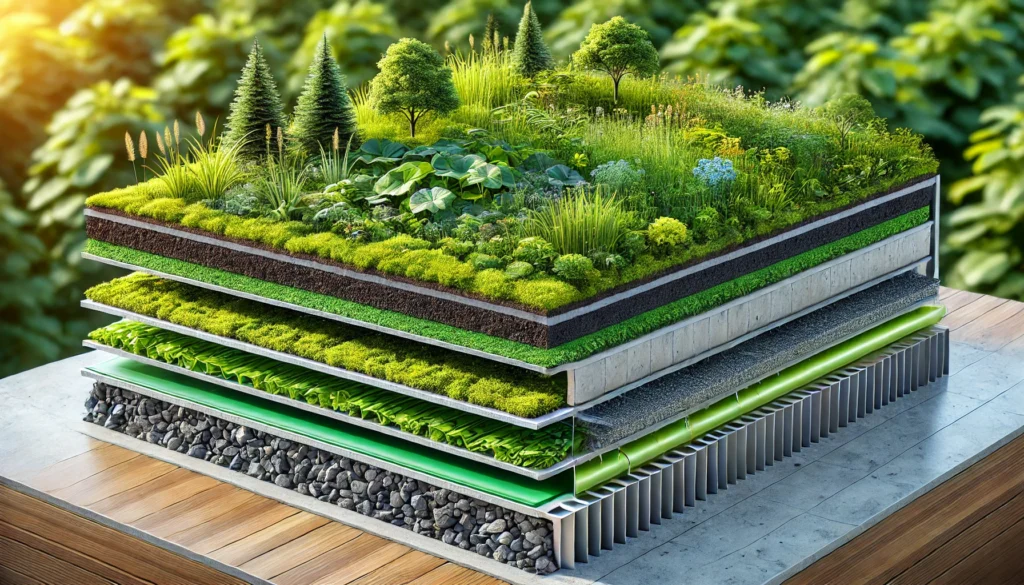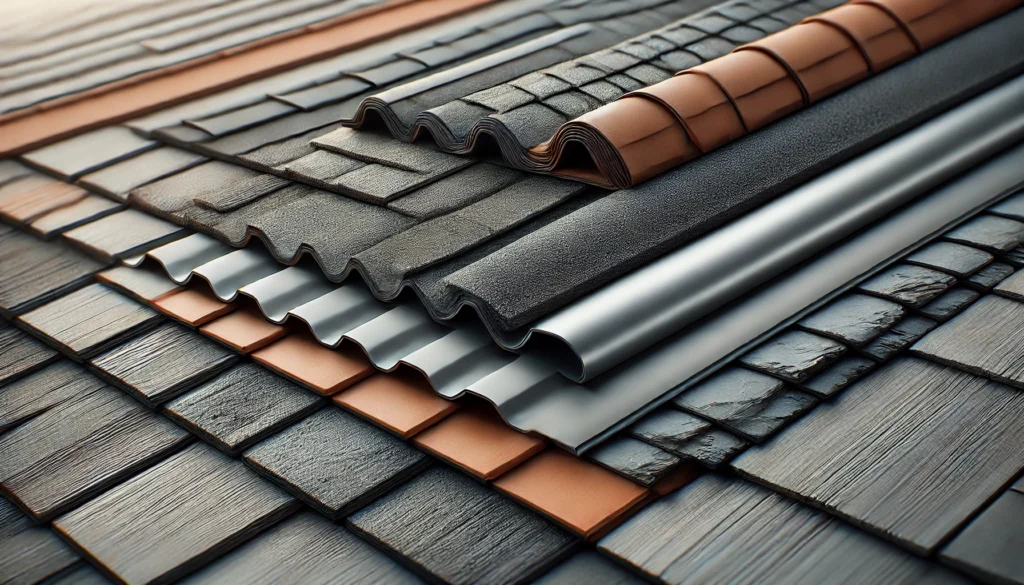When it comes to building or renovating a home, one of the most crucial decisions you will make is choosing the right roofing material. The roof is not only responsible for protecting your home from the elements, but it also plays a significant role in the overall aesthetic appeal, energy efficiency, and long-term value of the property. With a wide range of materials available on the market, understanding the pros and cons of each type will help you make an informed decision.
In this guide, we will explore various roofing materials, their advantages and disadvantages, and provide insights into installation processes. Whether you are a homeowner planning a roof replacement or a contractor advising clients, this article is your go-to resource for everything related to roofing materials.
Asphalt Shingles
Asphalt shingles are the most commonly used roofing material in residential construction due to their affordability and ease of installation. These shingles are typically made from a fiberglass base, coated with asphalt, and topped with mineral granules for added protection.
Advantages
- Cost-effective: Asphalt shingles are one of the most affordable roofing options.
- Easy Installation: They are relatively easy to install, making them a popular choice for DIYers.
- Versatility: Available in a wide range of colors and styles, asphalt shingles can complement any architectural design.
- Durability: With proper maintenance, asphalt shingles can last 20–30 years.
Disadvantages
- Shorter Lifespan: Compared to other materials like metal or slate, asphalt shingles have a shorter lifespan.
- Susceptibility to Damage: They are more prone to damage from severe weather conditions, such as strong winds and hail.
- Environmental Concerns: Asphalt shingles are not as eco-friendly as other materials because they are petroleum-based and challenging to recycle.
Installation Process
The installation process for asphalt shingles is relatively simple, typically involving the following steps:
- Surface Preparation: Ensure the roof deck is clean and dry.
- Installation of Underlayment: A waterproof underlayment is laid down to prevent water seepage.
- Shingle Installation: The shingles are installed from the bottom edge of the roof upwards, with each row overlapping the one below.
- Finishing Touches: Ridge caps and edge flashing are installed to seal off vulnerable areas.
Metal Roofing
Metal roofing has been gaining popularity due to its durability, energy efficiency, and modern appearance. Metal roofs are available in various materials, including aluminum, steel, copper, and zinc.
Types of Metal Roofs
- Standing Seam: Features raised seams that interlock to create a watertight seal.
- Metal Shingles: Resemble traditional roofing materials but are made from metal.
- Corrugated Metal: Characterized by its wavy pattern, often used in industrial settings.
Benefits
- Longevity: Metal roofs can last 40–70 years, making them a long-term investment.
- Energy Efficiency: Metal reflects solar heat, reducing cooling costs in warmer climates.
- Low Maintenance: Metal roofing requires minimal maintenance compared to other materials.
- Fire Resistance: Metal roofs are non-combustible, providing excellent protection against fires.
Drawbacks
- Higher Initial Cost: Metal roofs are more expensive than asphalt shingles.
- Noise: Rainfall can create noise, although this can be mitigated with proper insulation.
- Denting: Certain metals, like aluminum, may dent easily from hail or falling debris.
Installation Process
Installing a metal roof requires precision and attention to detail:
- Preparation: The roof deck is cleaned, and any damaged sections are repaired.
- Underlayment Installation: A high-quality underlayment is placed to protect against moisture.
- Panel Placement: Metal panels are aligned and secured with screws or fasteners.
- Sealing: Seams and edges are sealed to prevent water infiltration.
Clay and Concrete Tiles
Clay and concrete tiles are a timeless roofing choice, especially popular in regions with Mediterranean, Spanish, or Southwestern architecture. They offer superior durability and a distinctive aesthetic appeal.
Features of Clay vs. Concrete Tiles
- Clay Tiles: Made from natural clay, they are fired at high temperatures, creating a hard, durable product.
- Concrete Tiles: Made from a mixture of sand, cement, and water, they are molded into shape and left to harden.
Pros
- Longevity: Clay and concrete tiles can last 50–100 years.
- Aesthetic Appeal: These tiles provide a classic look that enhances curb appeal.
- Fire Resistance: Both clay and concrete tiles are highly resistant to fire.
- Eco-Friendly: Made from natural materials, they have a lower environmental impact.
Cons
- Heavy: These tiles are much heavier than other roofing materials, requiring reinforced roof structures.
- Expensive: Clay and concrete tiles are among the more expensive roofing options.
- Fragile: While durable, they can crack under heavy impact, such as from hail or falling branches.
Installation Process
Installing clay or concrete tiles involves careful handling due to their weight and fragility:
- Reinforcement of Roof Structure: The roof frame may need to be reinforced to handle the weight.
- Laying Tiles: The tiles are carefully placed in rows, overlapping to ensure water runoff.
- Fastening: Clips or mortar are used to secure the tiles in place.
Slate Roofing
Slate roofing is known for its beauty, durability, and longevity. Natural slate tiles are quarried and cut into flat, rectangular shapes, giving them a unique appearance that can enhance the aesthetic of any home.
Characteristics
- Material: Slate is a natural stone, making it highly durable and resistant to weathering.
- Appearance: Slate tiles are available in various colors, ranging from black and gray to purple and green.
Advantages
- Durability: Slate roofs can last over 100 years with proper maintenance.
- Fire and Weather Resistant: Slate is highly resistant to fire, wind, and severe weather conditions.
- Eco-Friendly: As a natural material, slate has a minimal environmental impact.
Disadvantages
- Cost: Slate is one of the most expensive roofing materials.
- Weight: Like clay tiles, slate is heavy and may require additional roof support.
- Fragility: Slate tiles can break if walked on or subjected to heavy impact.
Installation Process
Due to the weight and fragility of slate, professional installation is highly recommended:
- Roof Deck Preparation: The roof deck is reinforced to support the heavy weight.
- Tile Placement: Slate tiles are carefully placed, starting from the bottom of the roof.
- Securing: Tiles are fastened using copper or stainless steel nails, which prevent corrosion over time.
Wood Shingles and Shakes
Wood roofing materials, such as cedar shingles and shakes, offer a rustic and natural appearance. Though less common today, they remain a popular choice for traditional or historic homes.
Differences Between Shingles and Shakes
- Shingles: Thin, smooth, and uniform in shape, providing a more refined look.
- Shakes: Thicker, hand-split, and less uniform, offering a rougher, more textured appearance.
Benefits
- Natural Insulation: Wood provides natural insulation, reducing energy costs.
- Aesthetic Appeal: Wood shingles and shakes add character and warmth to the home’s exterior.
- Sustainability: If sourced responsibly, wood roofing materials can be an eco-friendly option.
Drawbacks
- Maintenance: Wood roofs require regular maintenance to prevent mold, rot, and insect damage.
- Fire Hazard: Unless treated, wood is highly flammable.
- Cost: Wood roofs are more expensive than asphalt shingles but less expensive than slate or metal.
Installation Process
The installation of wood shingles or shakes is a specialized process:
- Surface Preparation: The roof deck is cleaned, and a breathable underlayment is installed.
- Shingle/Shake Placement: Each piece is individually nailed to the roof deck, with overlapping rows for water resistance.
- Finishing: Ridge caps and additional treatments for fire resistance may be applied.
Synthetic Roofing Materials
Synthetic roofing materials, including rubber, plastic, and polymer-based products, are designed to mimic the appearance of natural materials like slate or wood but with enhanced durability and affordability.
Popular Types
- Synthetic Slate: Made from recycled rubber or plastic, mimicking natural slate.
- Composite Shingles: Created from a mix of materials, designed to resemble wood or asphalt shingles.
Pros
- Durability: Resistant to cracking, warping, and fading.
- Lightweight: Easier to install and does not require reinforced roof structures.
- Cost-effective: Less expensive than natural materials like slate or wood.
Cons
- Appearance: While they mimic natural materials, some homeowners feel synthetic roofing lacks the authenticity of the real thing.
- Longevity: Synthetic materials may not last as long as their natural counterparts.
Installation Process
Installation is similar to traditional materials:
- Underlayment Installation: A waterproof underlayment is laid down.
- Panel or Shingle Placement: Synthetic shingles or panels are installed, often using the same methods as their natural counterparts.
- Sealing: Joints and edges are sealed to ensure water resistance.

Green Roofing
Green roofing, also known as living roofs, involves the installation of vegetation on the roof surface, offering environmental and energy-saving benefits.
What is Green Roofing?
Green roofs consist of a waterproof membrane covered by soil and plants. They can be either extensive (low-maintenance with shallow soil) or intensive (high-maintenance with deep soil, capable of supporting larger plants).
Benefits
- Insulation: Green roofs provide natural insulation, reducing energy costs.
- Environmental Impact: They reduce stormwater runoff, improve air quality, and promote biodiversity.
- Aesthetic Appeal: Green roofs can enhance the look of both residential and commercial properties.
Drawbacks
- Cost: Green roofs require significant upfront investment, particularly for intensive systems.
- Maintenance: Regular maintenance is needed to ensure plant health and prevent leaks.
Installation Process
Green roofs require careful planning and a specialized installation process:
- Waterproofing: A waterproof membrane is installed to prevent leaks.
- Drainage Layer: A drainage layer is added to allow excess water to escape.
- Soil and Planting: Soil is spread over the roof, and vegetation is planted.
FAQs on Roofing Material
1. What are the top 5 roofing materials?
The top 5 roofing materials are:
- Asphalt Shingles: Affordable and easy to install, commonly used in residential homes.
- Metal Roofing: Known for its durability and energy efficiency.
- Clay and Concrete Tiles: Popular for their longevity and classic aesthetic.
- Slate Roofing: A high-end option, offering unparalleled durability and a natural look.
- Wood Shingles and Shakes: Ideal for a rustic appearance, offering natural insulation.
2. What are the materials used in roofing?
Common roofing materials include:
- Asphalt shingles
- Metal (aluminum, steel, copper)
- Clay or concrete tiles
- Slate
- Wood shingles and shakes
- Synthetic materials (rubber, plastic, or composite)
- Green roofing (vegetation)
3. What are the three types of roofing materials?
The three main types of roofing materials are:
- Asphalt Shingles: Most popular for residential use.
- Metal Roofing: Gaining popularity for its longevity and energy efficiency.
- Clay or Concrete Tiles: Preferred in regions with Mediterranean or Spanish-style architecture.
4. What is the material generally used for roofing?
Asphalt shingles are the most commonly used roofing material, especially in residential construction due to their cost-effectiveness and ease of installation.
5. What is the best roof covering?
The best roof covering depends on various factors like budget, climate, and aesthetic preferences. However, metal roofing is often considered one of the best options due to its durability, energy efficiency, and low maintenance.
6. What is the most efficient roofing material?
Metal roofing is the most energy-efficient roofing material, reflecting solar heat and reducing cooling costs, especially in hot climates.
Conclusion
Choosing the right roofing material is a significant decision that impacts your home’s appearance, energy efficiency, and longevity. While cost is a major factor, it’s also important to consider the durability, maintenance, and environmental impact of the materials you choose. Whether you’re looking for affordability, sustainability, or aesthetic appeal, there is a roofing material that will meet your needs.
For more detailed advice on roofing materials, inspections, and structural assessments in Malaysia, visit Pro Inspect Solution.


